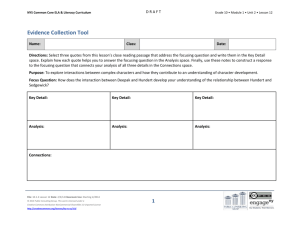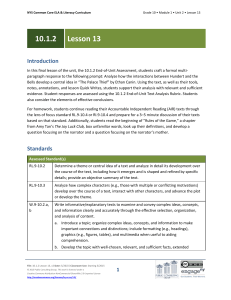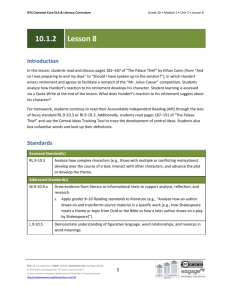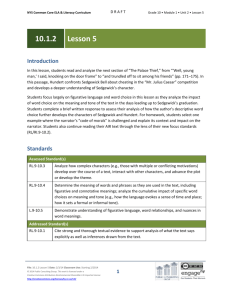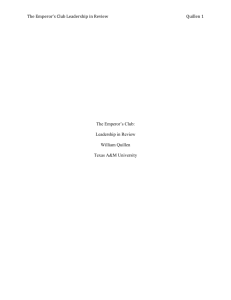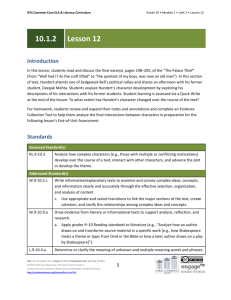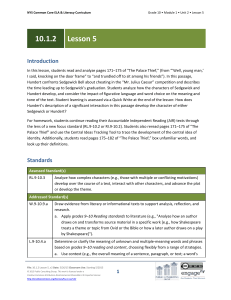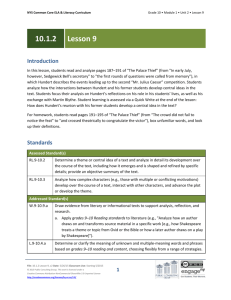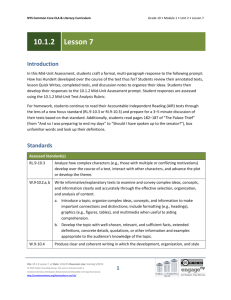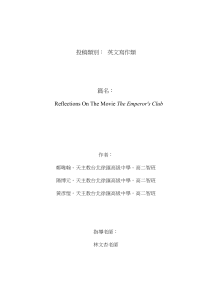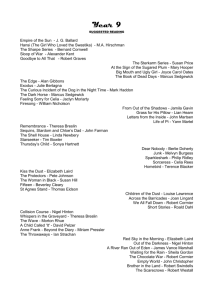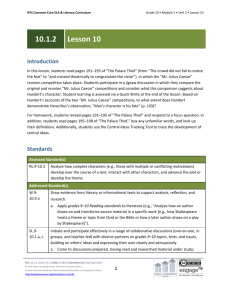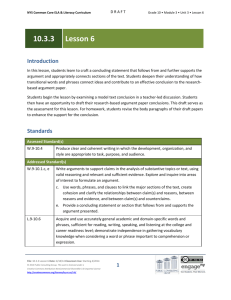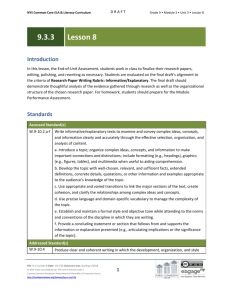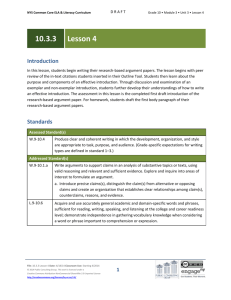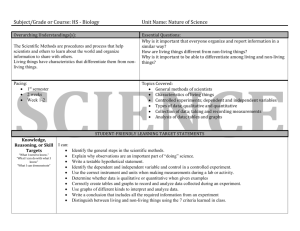Grade 10 ELA Module 1, Unit 2, Lesson 11
advertisement
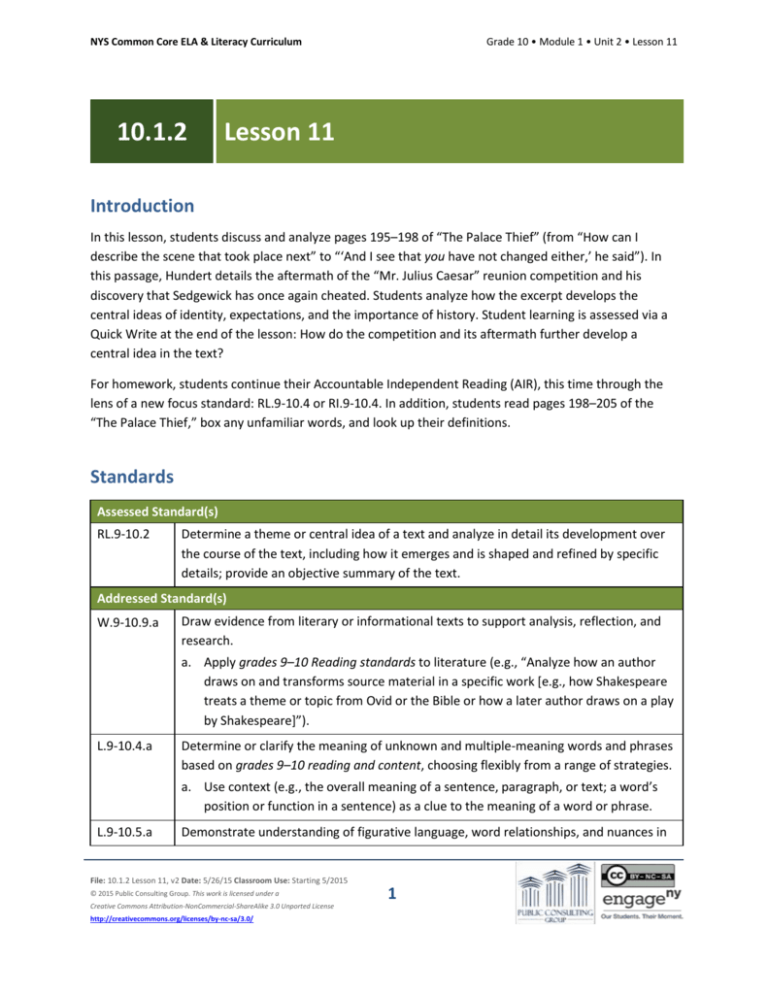
NYS Common Core ELA & Literacy Curriculum 10.1.2 Grade 10 • Module 1 • Unit 2 • Lesson 11 Lesson 11 Introduction In this lesson, students discuss and analyze pages 195–198 of “The Palace Thief” (from “How can I describe the scene that took place next” to “‘And I see that you have not changed either,’ he said”). In this passage, Hundert details the aftermath of the “Mr. Julius Caesar” reunion competition and his discovery that Sedgewick has once again cheated. Students analyze how the excerpt develops the central ideas of identity, expectations, and the importance of history. Student learning is assessed via a Quick Write at the end of the lesson: How do the competition and its aftermath further develop a central idea in the text? For homework, students continue their Accountable Independent Reading (AIR), this time through the lens of a new focus standard: RL.9-10.4 or RI.9-10.4. In addition, students read pages 198–205 of the “The Palace Thief,” box any unfamiliar words, and look up their definitions. Standards Assessed Standard(s) RL.9-10.2 Determine a theme or central idea of a text and analyze in detail its development over the course of the text, including how it emerges and is shaped and refined by specific details; provide an objective summary of the text. Addressed Standard(s) W.9-10.9.a Draw evidence from literary or informational texts to support analysis, reflection, and research. a. Apply grades 9–10 Reading standards to literature (e.g., “Analyze how an author draws on and transforms source material in a specific work [e.g., how Shakespeare treats a theme or topic from Ovid or the Bible or how a later author draws on a play by Shakespeare]”). L.9-10.4.a Determine or clarify the meaning of unknown and multiple-meaning words and phrases based on grades 9–10 reading and content, choosing flexibly from a range of strategies. a. Use context (e.g., the overall meaning of a sentence, paragraph, or text; a word’s position or function in a sentence) as a clue to the meaning of a word or phrase. L.9-10.5.a Demonstrate understanding of figurative language, word relationships, and nuances in File: 10.1.2 Lesson 11, v2 Date: 5/26/15 Classroom Use: Starting 5/2015 © 2015 Public Consulting Group. This work is licensed under a Creative Commons Attribution-NonCommercial-ShareAlike 3.0 Unported License http://creativecommons.org/licenses/by-nc-sa/3.0/ 1 NYS Common Core ELA & Literacy Curriculum Grade 10 • Module 1 • Unit 2 • Lesson 11 word meanings. a. Interpret figures of speech (e.g., euphemism, oxymoron) in context and analyze their role in the text. Assessment Assessment(s) Student learning is assessed via a Quick Write at the end of the lesson. Students respond to the following prompt, citing textual evidence to support analysis and inferences drawn from the text. How do the competition and its aftermath further develop a central idea in the text? High Performance Response(s) A High Performance Response should: Identify a central idea in the excerpt (e.g., expectations, identity, or history). Analyze how Hundert’s description of the competition and its aftermath further develops this central idea (e.g., Hundert’s description of the competition and its aftermath further develop the central idea of identity through Hundert’s reflections that Sedgewick’s identity is based on his childhood. Hundert implies that Sedgewick’s family and upbringing have contributed to his identity when he hears Sedgewick speak into the microphone and states that he “recognized … the willowtree drawl of his father” (p. 195). When Sedgewick announces his candidacy for the Senate, Hundert realizes he should not have been surprised because Sedgewick’s ambition was to be expected in a boy who “had stood so near to the mantle of power that its shadow must have been as familiar to him as his boyhood home” (p. 196). Similarly, Hundert says he should not have been surprised by Sedgewick’s deceit because “[v]irtue had no place in the palaces [Sedgewick] had known” (p. 196). While Hundert believes that the senator was a major force in shaping Sedgewick’s identity, he also recognizes that Sedgwick’s identity is marked by certain innate qualities, such as his leadership. Hundert says that since childhood, Sedgewick’s leadership had been evident “in his oratory, in his physical presence, [and] in his conviction” (p. 196). Sedgewick, however, is not the only character whose identity seems unchanged. When Sedgewick says goodbye to Hundert he tells him, “And I see that you have not changed either” (p. 198). Sedgewick’s words suggest that Hundert, like Sedgewick, has remained the same.). Vocabulary Vocabulary to provide directly (will not include extended instruction) potentate (n.) – a person who possesses great power or authority, as a sovereign, monarch, File: 10.1.2 Lesson 11, v2 Date: 5/26/15 Classroom Use: Starting 5/2015 © 2015 Public Consulting Group. This work is licensed under a Creative Commons Attribution-NonCommercial-ShareAlike 3.0 Unported License http://creativecommons.org/licenses/by-nc-sa/3.0/ 2 NYS Common Core ELA & Literacy Curriculum Grade 10 • Module 1 • Unit 2 • Lesson 11 or ruler abated (v.) – reduced in amount, degree, intensity, etc.; lessened; diminished chastened (v.) – restrained; subdued veracity (n.) – conformity to truth or fact; accuracy assiduously (adv.) – constantly, unremittingly Vocabulary to teach (may include direct word work and/or questions) spurned (v.) – rejected with disdain; scorned sovereign (n.) – a monarch; a king, queen, or other supreme ruler vindication (n.) – the state of being cleared, as from an accusation or suspicion Additional vocabulary to support English Language Learners (to provide directly) deft (adj.) – skillful and clever supplication (n.) – an act of asking for something in a respectful way potent (adj.) – very effective or strong Lesson Agenda/Overview Student-Facing Agenda % of Lesson Standards & Text: Standards: RL.9-10.2, W.9-10.9.a, L.9-10.4.a, L.9-10.5.a Text: “The Palace Thief” from The Palace Thief by Ethan Canin, pages 195–198 Learning Sequence: 1. 2. 3. 4. 5. 6. Introduction of Lesson Agenda Homework Accountability Masterful Reading Reading and Discussion Quick Write Closing 1. 2. 3. 4. 5. 6. Materials Student copies of the Short Response Rubric and Checklist (refer to 10.1.1 Lesson 1) File: 10.1.2 Lesson 11, v2 Date: 5/26/15 Classroom Use: Starting 5/2015 © 2015 Public Consulting Group. This work is licensed under a Creative Commons Attribution-NonCommercial-ShareAlike 3.0 Unported License http://creativecommons.org/licenses/by-nc-sa/3.0/ 3 5% 15% 10% 50% 10% 10% NYS Common Core ELA & Literacy Curriculum Grade 10 • Module 1 • Unit 2 • Lesson 11 Learning Sequence How to Use the Learning Sequence Symbol Type of Text & Interpretation of the Symbol 10% no symbol Percentage indicates the percentage of lesson time each activity should take. Plain text indicates teacher action. Bold text indicates questions for the teacher to ask students. Italicized text indicates a vocabulary word. Indicates student action(s). Indicates possible student response(s) to teacher questions. Indicates instructional notes for the teacher. Activity 1: Introduction of Lesson Agenda 5% Begin by reviewing the agenda and assessed standard for this lesson: RL.9-10.2. In this lesson, students continue to analyze how Hundert’s reflections and actions in the aftermath of the “Mr. Julius Caesar” reunion competition develop central ideas in the text. Students look at the agenda. Activity 2: Homework Accountability 15% Instruct students to take out their responses to the first part of the previous lesson’s homework assignment. (Reread pages 191–195 of “The Palace Thief and respond to the following focus prompt: Based on Hundert’s accounts of the two “Mr. Julius Caesar” competitions, to what extent does Sedgewick demonstrate Heraclitus’s observation, “Man’s character is his fate” (p. 193)?) Instruct students to share their responses in pairs. Sedgewick Bell’s decision to cheat a second time supports Heraclitus’s belief that “Man’s character is his fate” (p. 193). Sedgewick’s character, corrupted by the “mighty forces” (p. 170) that twisted his life, causes him to cheat during the “rematch” (p. 182). Hundert first expresses surprise at Sedgewick’s success in the competition, commenting, “It does not happen as often as one might think that an unintelligent boy becomes an intelligent man, for in my own experience the love of thought is rooted in an age long before adolescence” (p. 192). Since Sedgewick showed no evidence of a “love of thought” as a student, Hundert is impressed by his current mastery of the material and begins to hope that Sedgewick has, in fact, changed. However, Hundert soon learns that Sedgewick, now “one of the most powerful men in America” (p. 193), has chosen to hire a “mercenary professor” (p. 194) rather than to “reclaim his intellectual honor” (p. 183) by learning the material on the “flash cards of Roman history” (p. 188) that he File: 10.1.2 Lesson 11, v2 Date: 5/26/15 Classroom Use: Starting 5/2015 © 2015 Public Consulting Group. This work is licensed under a Creative Commons Attribution-NonCommercial-ShareAlike 3.0 Unported License http://creativecommons.org/licenses/by-nc-sa/3.0/ 4 NYS Common Core ELA & Literacy Curriculum Grade 10 • Module 1 • Unit 2 • Lesson 11 had showed Hundert earlier. By choosing to recreate the earlier competition, including a deceptive method of ensuring victory, Sedgewick demonstrates that he remains unchanged and that he is therefore bound to cheat a second time, illustrating Heraclitus’s belief that a man’s character is his fate. Lead a brief whole-class discussion of student responses. Instruct student pairs to share and discuss the vocabulary words they identified in the previous lesson’s homework. Students may identify the following words: potentate, abated, chastened, veracity, and assiduously. Differentiation Consideration: Students may also identify the following words: deft, supplication, and potent. Definitions are provided in the Vocabulary box in this lesson. Instruct students to share and discuss the central ideas they identified for the previous lesson’s homework, paying particular attention to the central idea of expectations. Instruct students to form pairs and share their notes on the Central Ideas Tracking Tool. Student pairs share text evidence related to the central ideas. See Model Central Ideas Tracking Tool sample student responses. Activity 3: Masterful Reading 10% Have students listen to a masterful reading of pages 195–198 (from “The Palace Thief,” from “How can I describe the scene that took place next” to “‘And I see that you have not changed either,’ he said”). Consider pausing several times during the masterful reading to allow students time to write down initial reactions and questions. Students follow along, reading silently. Differentiation Consideration: Consider posting or projecting the following guiding question to support students in their reading throughout this lesson: Why did Sedgewick organize the “Mr. Julius Caesar” reunion competition? File: 10.1.2 Lesson 11, v2 Date: 5/26/15 Classroom Use: Starting 5/2015 © 2015 Public Consulting Group. This work is licensed under a Creative Commons Attribution-NonCommercial-ShareAlike 3.0 Unported License http://creativecommons.org/licenses/by-nc-sa/3.0/ 5 NYS Common Core ELA & Literacy Curriculum Grade 10 • Module 1 • Unit 2 • Lesson 11 Activity 4: Reading and Discussion 50% Instruct students to form small groups. Post or project each set of questions below for students to discuss. Instruct students to annotate for central ideas throughout the reading and discussion, using the code CI. This focused annotation supports students’ engagement with W.9-10.9.a, which addresses the use of textual evidence in writing. Instruct student groups to reread pages 195–198 of “The Palace Thief” (from “How can I describe the scene that took place next” to “‘And I see that you have not changed either,’ he said”) and answer the following questions before sharing out with the class. How does Hundert’s opinion of Sedgwick based on the second cheating incident contribute to the development of a central idea of the text? Student responses should include: o o Hundert’s opinion of Sedgewick further develops the central idea of identity as unchanging. Hundert identifies the forces that formed Sedgewick’s identity: “since childhood the boy had stood so near to the mantle of power that its shadow must have been as familiar to him as his boyhood home. Virtue had no place in the palaces he had known” (p. 196). Hundert’s opinion of Sedgewick as a man “blindly ignorant of history” (p. 196) further develops the central idea of history by suggesting that Hundert believes Sedgewick, despite his abilities and background, is not fit to be a leader because he cannot appreciate the lessons of history, which Hundert believes teach men to counter “arrogance” (p. 155) and “temper … ambition with humility” (p. 157). How do Hundert’s thoughts during the night after the competition develop a central idea of the text? The events of the evening reflect a change in Hundert’s view of history. Hundert’s description of his thoughts during the night after the competition develop the central idea of history by presenting a much darker view of humanity than he had expressed earlier. In the past, Hundert viewed history as a means of “understand[ing] the importance of character and high ideals” (p. 163), but now Hundert uses negative words to describe his thoughts, saying his mind raced “through humanity’s endless history of injustice, depravity, and betrayal” (p. 197). These thoughts demonstrate Hundert’s realization that history can negatively influence the present. How does Hundert’s use of figurative language on page 197 develop a central idea of the text? Hundert uses a metaphor to compare himself to a “spurned sovereign,” or a rejected king, and Sedgewick to a “false potentate,” or an imposter ruling as a king. The metaphor develops the central idea of expectations. Sedgewick’s cheating demonstrates that Hundert did not succeed File: 10.1.2 Lesson 11, v2 Date: 5/26/15 Classroom Use: Starting 5/2015 © 2015 Public Consulting Group. This work is licensed under a Creative Commons Attribution-NonCommercial-ShareAlike 3.0 Unported License http://creativecommons.org/licenses/by-nc-sa/3.0/ 6 NYS Common Core ELA & Literacy Curriculum Grade 10 • Module 1 • Unit 2 • Lesson 11 in meeting this expectation. Sedgewick, not Hundert, is the man who has dominated the evening, causing Hundert to view him as a “false potentate.” Differentiation Consideration: If students struggle, consider posing the following scaffolding questions: How do Hundert’s actions clarify the meaning of spurned sovereign (p. 197)? Hundert feels rejected; the “castle tower” makes it sound like someone who was part of royalty, so “spurned sovereign” is a member of royalty who feels rejected. How does the final interaction between Hundert and Sedgewick clarify the meaning of the word vindication (p. 198)? Hundert’s vindication felt “sweet” because by finally confronting Sedgewick about the reunion competition, he proved to himself that he could meet the “high ideals” he tried to teach his students (p. 163). Hundert was relieved that he had cleared himself of the unspoken accusation that he had failed to live by his “code of morals” (p. 172). Therefore, vindication must be a word akin to justified or cleared. Consider drawing students’ attention to the application of L.9-10.4.a through the process of using context to make meaning of unknown words. How does Hundert’s use of figurative language on page 197 relate to the title of the story? Hundert compares himself to a “spurned sovereign” and Sedgewick to a “false potentate,” both rulers who would live in a palace. Sedgewick, the “false potentate,” has displaced Hundert, the “spurned sovereign,” as the center of attention and so has “stolen” Hundert’s honor. He has also stolen Hundert’s faith in history as a way to “understand the importance of character and high ideals” (p. 163) by cheating a second time and using the event not as a means of “reclaim[ing] his intellectual honor” (p. 183), but of beginning his campaign for the Senate. He has taken what is dear to Hundert, the “Mr. Julius Caesar” competition, and used it for his own purposes and is “The Palace Thief.” Consider drawing students’ attention to the application of L.9-10.5.a through the process of interpreting figurative language and analyzing its role in the text. How does Sedgewick’s response to Hundert, “And I see that you have not changed either” (p. 198), develop a central idea of the text? Sedgewick’s words develop the idea of identity because they suggest that Hundert’s identity has remained unchanged and that Sedgewick knew, just as he did as a child, that Hundert “lacked the character” to confront him (p. 173). File: 10.1.2 Lesson 11, v2 Date: 5/26/15 Classroom Use: Starting 5/2015 © 2015 Public Consulting Group. This work is licensed under a Creative Commons Attribution-NonCommercial-ShareAlike 3.0 Unported License http://creativecommons.org/licenses/by-nc-sa/3.0/ 7 NYS Common Core ELA & Literacy Curriculum Grade 10 • Module 1 • Unit 2 • Lesson 11 Lead a brief whole-class discussion of student responses. Activity 5: Quick Write 10% Instruct students to respond briefly in writing to the following prompt: How do the competition and its aftermath further develop a central idea in the text? Ask students to use this lesson’s vocabulary wherever possible in their written responses. Remind students to use the Short Response Rubric and Checklist to guide their written responses. Students listen and read the Quick Write prompt. Display the prompt for students to see, or provide the prompt in hard copy. Transition to the independent Quick Write. Students independently answer the prompt using evidence from the text. See the High Performance Response at the beginning of this lesson. Activity 6: Closing 10% Display and distribute the homework assignment. For homework, students should continue to read their AIR texts through the lens of a new focus standard, RL.9-10.4 or RI.9-10.4, and prepare for a 3–5 minute discussion of their texts based on one of these new standards. Introduce standards RL.9-10.4 and RI.9-10.4 as focus standards to guide students’ AIR and model what applying a focus standard looks like. For example, RL.9-10.4 asks students to “determine the meaning of words and phrases as they are used in the text, including figurative and connotative meanings; analyze the cumulative impact of specific word choices on meaning and tone (e.g., how the language evokes a sense of time and place; how it sets a formal or informal tone).” Students who have read “The Palace Thief” might note that images like “spurned sovereign,” “castle tower,” “procession,” and “false potentate” (p. 197) impact the meaning of the text by suggesting that Hundert is the fallen king who has been betrayed by Sedgewick, a false king (p. 197). Instruct students to prepare for a brief 3–5 minute discussion that will ask them to apply the language of the standard to their texts. Also for homework, instruct students to read pages 198–205 of the “The Palace Thief” (from “Well had I? As the craft lifted” to “quietest of my boys, was now an old man”). Direct students to box any unfamiliar words and look up their definitions. Instruct them to choose the definition that makes the most sense in context and write a brief definition above or near the word in the text. Students follow along. File: 10.1.2 Lesson 11, v2 Date: 5/26/15 Classroom Use: Starting 5/2015 © 2015 Public Consulting Group. This work is licensed under a Creative Commons Attribution-NonCommercial-ShareAlike 3.0 Unported License http://creativecommons.org/licenses/by-nc-sa/3.0/ 8 NYS Common Core ELA & Literacy Curriculum Grade 10 • Module 1 • Unit 2 • Lesson 11 Homework Continue reading your Accountable Independent Reading (AIR) text through the lens of a new focus standard (RL.9-10.4 or RI.9-10.4) and prepare for a 3–5 minute discussion of your text based on that standard. In addition, read pages 198–205 of the “The Palace Thief” (from “Well had I? As the craft lifted” to “quietest of my boys, was now an old man”) and box any unfamiliar words and look up their definitions. Choose the definition that makes the most sense in context and write a brief definition above or near the word in the text. File: 10.1.2 Lesson 11, v2 Date: 5/26/15 Classroom Use: Starting 5/2015 © 2015 Public Consulting Group. This work is licensed under a Creative Commons Attribution-NonCommercial-ShareAlike 3.0 Unported License http://creativecommons.org/licenses/by-nc-sa/3.0/ 9 NYS Common Core ELA & Literacy Curriculum Grade 10 • Module 1 • Unit 2 • Lesson 11 Model Central Ideas Tracking Tool Name: Class: Date: Directions: Identify the central ideas that you encounter throughout the text. Trace the development of those ideas by noting how the author introduces, develops, or refines these ideas in the texts. Cite textual evidence to support your work. Text: “The Palace Thief” by Ethan Canin Page # Central Ideas Notes and Connections Page 196 Identity Hundert says he should not have been surprised when he realizes that Sedgewick has “contrived the entire rematch … to gather his classmates for donations” because Sedgewick’s sense of himself was formed as a child who grew up surrounded by power and because “[v]irtue had no place in the palaces he had known.” Page 197 Identity Hundert sees himself as a “spurned sovereign in the castle tower” and considers Sedgewick a “false potentate.” Hundert’s descriptions suggest that he considers himself as someone worthy of respect, a “sovereign,” even though the men at the reunion give their respect to Sedgewick instead. Page 198 Identity Hundert refers to Sedgewick’s earpiece as a way of letting him know that he is aware of the deception. Sedgewick acknowledges his deceit and then insults Hundert by saying, “And I see that you have not changed either,” suggesting that just as Sedgewick’s identity has not changed over time, neither has Hundert’s. File: 10.1.2 Lesson 11, v2 Date: 5/26/15 Classroom Use: Starting 5/2015 © 2015 Public Consulting Group. This work is licensed under a Creative Commons Attribution-NonCommercial-ShareAlike 3.0 Unported License http://creativecommons.org/licenses/by-nc-sa/3.0/ 10
